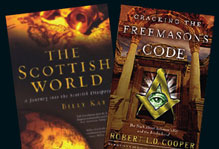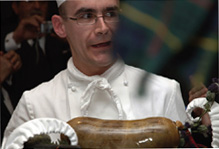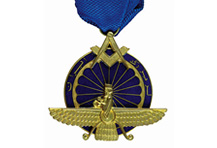The Grand Lodge of Scotland and the Burns House Museum spar over the origins of the poet’s freemasonic regalia.
They may look like tattered old pinnies, but to historians one of them is a hugely important masonic artefact.
The Grand Lodge of Scotland and the Burns House Museum, in Dumfriesshire, are at loggerheads over who owns the Freemason’s apron that once belonged to Robert Burns.
The Burns House Museum insists its apron, which is touring the country as part of an exhibition celebrating the 250th anniversary of the poet’s birth, is the genuine article.
The embroidered leather garment is said to have been given to Burns in 1791 by Charles Kirkpatrick Sharpe, of Hoddam, a close friend and fellow mason. However, the Grand Lodge of Scotland has produced a rival garment, which it says was given to Burns at St Andrew’s Lodge in Dumfries, where he was a senior officer until his death in 1796.
Its claim is supported by leading authorities on Burns and masonic regalia, who have dismissed the Burns House Museum apron as a fake. Burns became a Freemason in 1781 at the height of the organisation’s popularity and remained involved throughout his life.
He was a member of five lodges, including St Andrew’s Lodge, which he last visited three months before his death. While the museum’s apron has long been regarded as genuine, the Grand Lodge will stake its claim when its apron is unfurled for the first time in public at the second conference on the History of Freemasonry in Edinburgh on May 29.
The apron was passed on to the Grand Lodge in the 1880s after St Andrew’s Lodge stopped meeting, along with a minute book proving Burns had been a member. It has since been restored and kept safe while its provenance was being checked.
According to Robert Cooper, curator of the Grand Lodge of Scotland, the apron can be seen clearly in an etching of Burns in his masonic regalia made for St Andrew’s Lodge some 90 years after his death. He says he was convinced it belonged to Burns because a masonic symbol, the letter G, was accidentally sewn as the number six. “The letter G that was on the flap as you see it in the engraving is not a G, it’s a 6.
It was probably made by a man who couldn’t sew. The apron we have is identical to that. It is a mistake, but it actually proves the provenance,” he said. “It took quite a lot of work, and quite a few thousand pounds to stabilise it [the apron]. It has not been restored to its original condition, but it has been stabilised.
“It is hugely important because this is something this man actually wore as a mason, it is a physical relic, a tangible connection to Robert Burns’s involvement in the masons.” Commenting on the apron owned by the Burns House Museum, Cooper added: “I have always been a bit suspicious about its provenance.
A lot of the artefacts that were associated with him are scattered. It is a field that is rich in things of unproven provenance.”
aul Rich, president of the Policy Studies Organisation in Washington, and a leading authority on Freemasonry, said he did not believe the Burns House Museum apron was owned by Burns.
Rich, who will put his case at the conference in Edinburgh, said he became convinced that it was a fake while researching a birthday speech about Burns for the event. The apron is inscribed, “Charles Sharpe of Hotham to Rabbie Burns, Dumfries, Dec 12 1791”, but authorities on Burns say the poet was never known as ‘Rabbie’ during his lifetime.
Dr Gerard Carruthers, director of Glasgow University’s Centre for Robert Burns Studies, agrees: “He was known under other names, but not this, not while he was still alive.” The Dumfries and Galloway Museums Service, which owns the Burns House Museum, said that the inscription could have been written on the garment after Burns’s death.
Julia BelgutayThe Sunday Times May 3, 2009


